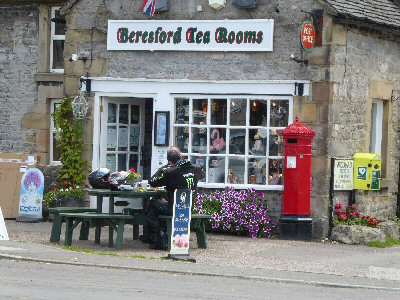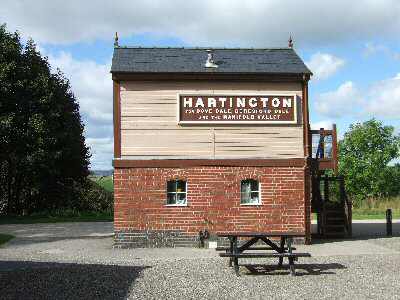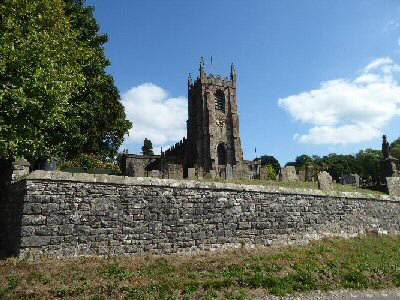HARTINGTON
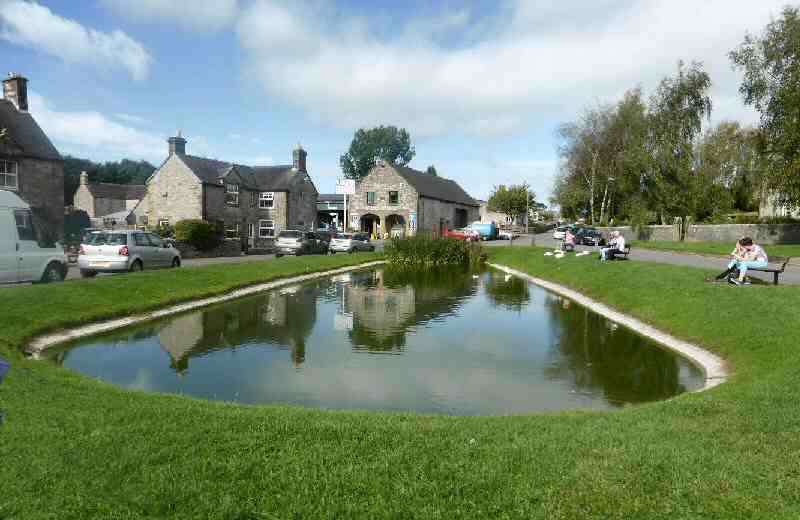
PLAN YOUR VISIT
Location: Hartington is on the B5054 about two miles west of the A515 Ashbourne to Buxton Road (SK129604).

Visit: Explore the village and walk down to Beresford Dale, one of the prettiest dales in the Peak District.
Refreshments: Charles Cotton Hotel is a traditional country hotel; Devonshire Arms is a 17th-century village pub with seating inside and out; Beresford Tea Rooms is a long-established business serving morning coffee, lunches, and afternoon teas; Hartington Farm Shop and Café is a recently established business.
Walk: Hartington Three Dales Walk descends gently to Beresford Dale, where the River Dove meanders slowly through a beautifully wooded dale, over a succession of tiny weirs. Once across the water meadow, Wolfscote Dale is entered, which becomes progressively more spectacular as you walk, with the sides of the dale rising almost vertically. Biggin Dale, in stark contrast, is dry except in wet weather.
Special Places of Interest in the Locality: Buxton has fine parks and grand old buildings. At well over 1,000 feet above sea level, Buxton is the highest town in England for its size. – Dovedale, with its steep-sided limestone sides and tree-covered slopes, is the stretch of the valley that runs from the tiny hamlet of Milldale down to the large car park close to the road linking Ilam and Thorpe. It is one of the country’s most visited free natural outdoor attractions. – Bakewell, a picturesque old market town, is set in an enviable location on the banks of the River Wye, in the heart of the Peak District.
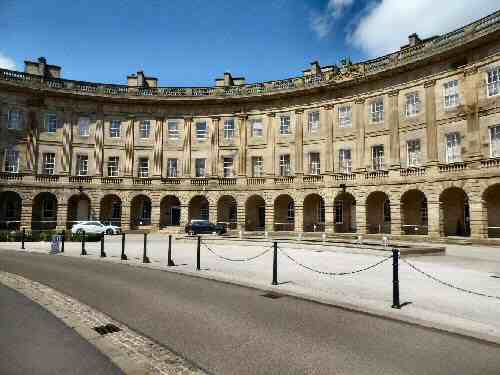
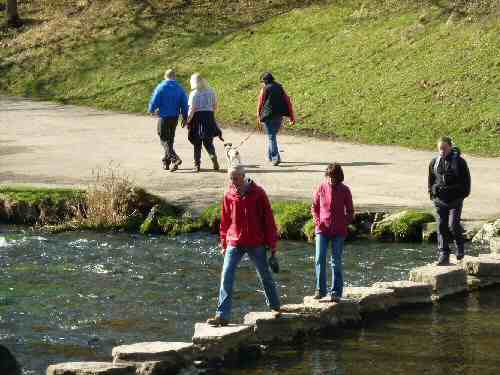
INTRODUCTION
Hartington is a picturesque village with a spacious marketplace and village green. Its delightful duck pond and limestone houses, which sparkle in the bright sunlight, make it one of the major tourist centres in the Peak District. It has more the air of a prosperous market town than a village.
It was the first in the Peak District to be granted a charter to hold weekly markets and an annual fair. However, these have long since ceased with the removal of commercial activity. Even today, the village has a range of services equivalent to those of a small town, despite a population of only about 400—apart from the tourists, of course! Many are attracted by the excellent walking facilities available.
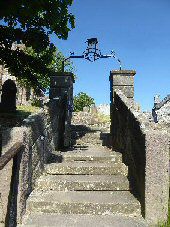
ST. GILES CHURCH
The size and stature of St. Giles Church provide further evidence of the village’s former status. Standing on rising ground with an impressive battlemented west tower, the church presents an imposing sight. Its construction is somewhat unusual, as both Staffordshire Redstone and Derbyshire limestone have been used with gritstone detailing to produce a pleasing result.
HARTINGTON HALL
Hartington Hall was the home of the Bateman family for over four hundred years and is an excellent example of a yeoman farmer’s house. Where Bonnie Prince Charlie is said to have slept on his ill-fated journey to London, it has been a Youth Hostel since 1934.
STILTON CHEESE
For many years, Hartington’s primary industry was cheese-making. The cheese factory at Hartington, which opened in the 1870s, was the only survivor of seven that operated in the area at one time. It had the distinction of achieving a Royal Warrant to supply Stilton to George V in the 1920s and 1930s.
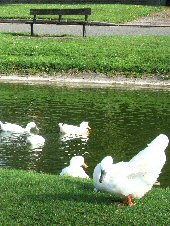
At its peak, the factory produced a quarter of the world’s supply of Stilton before closing earlier this century. Legally, Stilton can only be made in the three shire counties of Derby, Nottingham, and Leicester—had the original factory been a quarter mile to the west, it would not have qualified, as it would have been in Staffordshire! After the factory had been closed for three years, cheese-making production restarted in the parish. In October 2012, a company called Hartington Creamery was established thanks to five passionate individuals about cheese manufacturing and keeping production in Hartington alive. Several barns in the parish were converted into small-scale cheese factories. The firm recently received accreditation to make Stilton again.
A cheese shop has been established in Hartington for over thirty years in a beautiful old stone building overlooking the village duck pond. It is hugely popular with locals and visitors alike, but you can still order online if you cannot make it to the shop.
CHARLES COTTON
Charles Cotton, who lived at Beresford Hall, now demolished, wrote, with his great friend Izaak Walton, a remarkable book about 17th century rural England called ‘The Compleat Angler’. No English language book, besides the Bible and Book of Common Prayer, has been reprinted more times. He shared his time between an extravagant lifestyle in London society and the quieter pleasures of his home in the Peak District. That is when his creditors were not chasing him – then it is said he hid in a cave in Beresford Dale. The fishing lodge he built remains on private land in the dale but can be seen from a distance from the footpath approaching Beresford Dale.
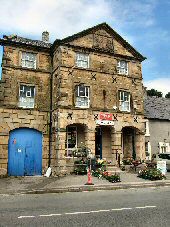
THE VILLAGE
Once an important stopping place for pack horses and drovers and then for stagecoaches, both The Charles Cotton and The Devonshire Arms are former coaching inns. Now, the village provides for tourists and local people, and there are several tempting cafes, quality gift and craft shops and a newsagent.
Most noticeable is the small supermarket housed in the rather grand old Market Hall, built in 1836, with three rusticated stone arches. The village pump on the green was regularly used before piped water arrived. The old Victorian letterbox that used to stand outside the former post office has been relocated further up the road, together with the post office. Regular events are held at the Village Hall, which started in 1926 as a silent picture house. Hartington Well Dressings and Country Show takes place in September each year.
PRESERVED RAILWAY SIGNAL BOX
An old preserved railway signal box is a short distance up the hill from the village. At busy times of the year, it operates as a small kiosk selling refreshments. After the railway closed in 1967, the line was converted into a pathway known as the Tissington Trail. It follows a 13-mile route from Ashbourne to Parsley Hay, where it joins the High Peak Trail, which runs from High Peak Junction to Dowlow near Buxton.

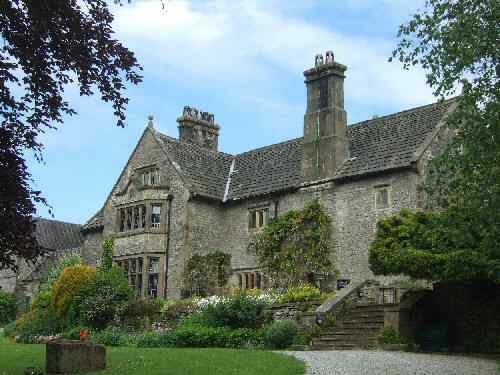
TEN FASCINATING FACTS ABOUT HARTINGTON
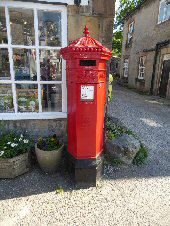
1. Hartington has produced some notable craftsmen; William Smith made the W G Grace Memorial Gates at Lord’s, the Spa bandstand at Scarborough and, locally, the lamp hanging for St Giles Church.
2. James Redfern, Smith’s uncle and a talented sculptor whose work appears in churches and cathedrals worldwide, including Westminster Abbey, was brought up in the village.
3. A craftsman of a different kind, John Oliver, the son of a lead miner, left England to work on the Canadian Pacific Railway before eventually becoming the Prime Minister of British Columbia in 1921.
4. Prince Obolenski, a Russian nobleman, lived at Dove Cottage for a time after fleeing the revolution in his country. He achieved immortality in Rugby circles by scoring two tries for England in a match against the formidable New Zealand All Blacks.
5. The Perry family built and opened a Silent Picture House in the village in 1926. It was later transformed into an Amusement Hall before eventually being purchased by the village in the early 1940s and converted into the Village Hall.
6. Except for Derby and Chesterfield, Hartington was the first in Derbyshire to be granted a Royal Market Charter in 1203 to hold a weekly market and an annual fair.
7. At the bottom of Hall Bank is a most unusual War Memorial: a collage of pure limestone rocks.
8. The late Victorian railway that once served Hartington came into service in 1899. In its heyday, it carried express trains from Manchester to London.
9. Until after the Second World War, a daily train delivered milk from Peak District farms to Finsbury Park, London. Also, several quarries opened along the track from where limestone was extracted and then sent by rail to industrial centres.
10. The Old School House in Church Street was built in 1758 by Richard Edensor of Watergap Farm. It features one of the county’s finest traditional Peakland stone slate roofs.
Hartington Three Dales Walk
